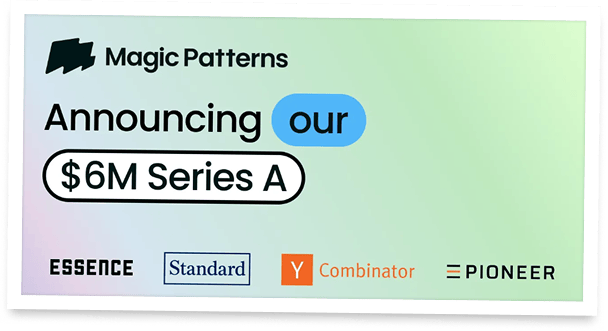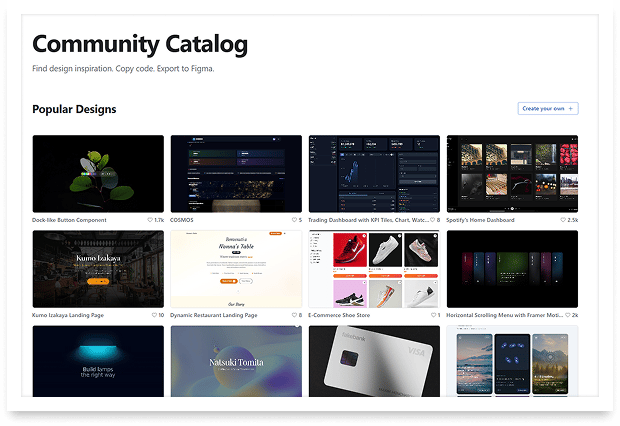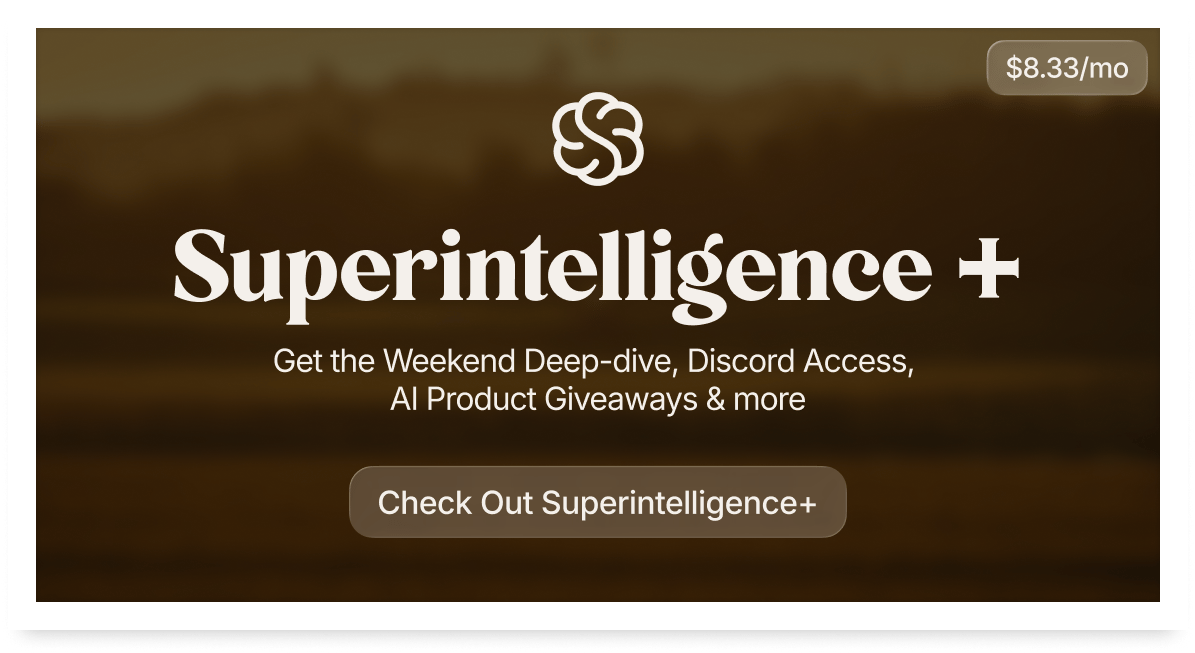
Dear Readers,
Today, we’re diving into something special: an interview with Alexander Danilowicz, co-founder of the AI-design startup Magic Patterns, the company that turned the prompt-to-UI dream into reality, backed by Y Combinator (Winter 2023) and fresh off a $6 million Series A funding round. Their mission? Helping product teams go from idea to production by generating real UI designs (and even exportable code) from simple text prompts.
In our conversation, Alex opens up about the messy startup grind, the pivoting moments that mattered, and what it really takes to build an AI-driven product in today’s hyper-competitive tooling ecosystem. He then takes us inside Magic Patterns: how it works, who it serves, and why it could matter for founders, designers, and investors alike.
Whether you’re building a startup, evaluating tooling for your team, or simply fascinated by the next wave of AI in design and product—this one’s for you. Sit back, dive in, and get inspired.

Enjoy the read!
All the best,



Kim Isenberg: Hi, I'm Kim, editor-in-chief of the Superintelligence newsletter. Alex, thank you so much for taking the time today – it's amazing to have you here. To get started, could you briefly introduce yourself and your journey so far, and then we’ll get into the history of your company?
Alexander Danilowicz: Thanks for having me, Kim. I’m Alex Danilowicz, co-founder of Magic Patterns, which I started with my best friend Teddy. We met in college studying computer science, moved to San Francisco after graduating, and both worked as front-end engineers. We loved front-end and product engineering, built a lot of side projects together, and eventually applied to Y Combinator. Out of that journey – and many pivots in design tooling – Magic Patterns was born.
Kim Isenberg: Let’s go back to the beginning. What was the moment or insight that led you to found Magic Patterns and build an AI-driven UI tool?
Alexander Danilowicz: We were pretty early to this space. When we did YC in Winter ’23, a lot of people still called AI a fad and compared it to crypto. ChatGPT had just launched in November 2022, and by January 2023, many people still thought, “This is never going to create real value.”
We tried several design tooling products: a design token manager, a Chrome extension that could grab parts of any website and spin up a preview, and then a component library editor. Components are the building blocks of your app – buttons, nav bars, inputs – and we built a way for designers to edit those and export code. That product had paying customers, but they barely used it. That taught us a hard lesson: it’s not enough that people pay; they have to use your product frequently. We added AI to make editing those components easier, and that ultimately evolved into Magic Patterns.
Kim Isenberg: How fast did Magic Patterns itself come together? Were there big “aha” moments, or did it feel more like grinding through problems?
Alexander Danilowicz: The MVP of Magic Patterns, as we know it – text prompt to web app – took about a week. It was based on GPT-3.5. You’d type “login page” and get two inputs and a button… or sometimes a random birthday form. The quality was rough at first.
The hardest part was the doubt: “What if the models don’t get better?” We underestimated how fast they would improve and didn’t fully believe in scaling laws early on. Because of our background and our component editor, we focused on generating small UI pieces – “generate your button” using your design system. What we should have believed much earlier was: you’ll be able to generate fully functional web apps, not just isolated components.
Kim Isenberg: You already mentioned YC, which brings us to fundraising. You were early in AI – how did you navigate that, and what did your fundraising journey look like?
Alexander Danilowicz: We just announced our Series A: 6 million dollars from Standard Capital, and we’re hiring rapidly now. What’s funny is that we scheduled this conversation long before we knew the timing.
But the road there was rough. During YC Demo Day, we essentially “failed.” We didn’t even present Magic Patterns – the company was still called Mirrorful, our component library editor. No one could pronounce the name, not many people used the product, and we raised around 100k while hotter companies in the batch were raising 2 million and more.
That experience forced discipline. We didn’t hire just to hire or raise just to raise. We stayed lean, kept moving through the “idea maze,” and that eventually brought us to Magic Patterns. It definitely wasn’t an overnight success. People see the Series A and the fact that we crossed 1 million dollars in ARR over the summer, but they don’t see the year of constant pivoting at YC with zero revenue.


Run ads IRL with AdQuick
With AdQuick, you can now easily plan, deploy and measure campaigns just as easily as digital ads, making them a no-brainer to add to your team’s toolbox.
You can learn more at www.AdQuick.com

Kim Isenberg: Everybody loves the success story, but the struggle in the middle is actually where the real learning happens. How did you navigate competition and the growing ecosystem of alternative tools?
Alexander Danilowicz: The first line of code for Magic Patterns was written in August 2023. At that time, most of the tools we know today didn’t exist. We were a bit slow to launch, and then in September 2023 V0 came out – an amazing product.
Early users who knew we were close to launching said things like, “You’re screwed, V0 just launched.” But by that point we’d already been through so many pivots that we interpreted V0’s launch as a positive signal. Vercel is a great company with extremely smart people. If they’re entering this space, the space is real.
Even as a two-person team, we were sometimes winning deals against V0. I’m very proud of that. Now we’re six people and still hiring quickly.
Kim Isenberg: Once you started hiring, how did you think about culture and company values? How did they emerge and evolve?
Alexander Danilowicz: In the very early days, it was just my co-founder and me – best friends shipping quickly. We didn’t talk about values; we just worked. Once we started building a team, we realized we had to make our implicit values explicit.
We wrote down a few core ones: optimize for action, trust the data, and be obsessed with customers. Customer obsession was always there – we genuinely love our customers and appreciate every single person who tries the tool. Another value is high ownership and high standards. We’re extremely proud of our product quality, and many teams choose us over bigger “enterprise” tools because of that. And then there’s “spread the magic”: be proud of your work, share it, and build experiences that feel magical to users.
I used to think, “Why do we need mission and values? Just ship code.” But once you have a team, you see those values were there all along – around product quality and customer happiness – and writing them down helps everyone pull in the same direction.
Kim Isenberg: Looking back, what would you do differently – particularly in fundraising, strategy, or product focus?
Alexander Danilowicz: We made a lot of mistakes, and there are definitely things I’d do differently. At the same time, I’m grateful for the journey. It’s always day one.
One big learning is the importance of a large total addressable market. Early on, we focused on a narrow problem: “make your design system with AI.” That was our first real launch. Instead, we should’ve had a bigger vision from the start: models will get better, and you’ll be able to build full web apps.
Another key lesson is how much you learn from users. In the beginning we told them, “We know you want to prompt a whole site, but it’s really just good for a button right now.” And then people would spend two hours inside Magic Patterns and tell us, “Hey, I just built a website.” That was a huge signal. Not enough founders talk about how much users shape the product versus pretending they knew everything from day one.
Kim Isenberg: Let’s talk more concretely about the product. In simple terms, what does Magic Patterns do, how does it use AI, and what can users achieve with it?
Alexander Danilowicz: We’re “text prompt to web app.” We help product teams – especially product managers and designers – go from idea to production. You can prompt something like “an onboarding form using our existing product styles,” and then iterate: add “Sign in with Google”, tweak hover states, change layout, and so on.
The magic is that you explore these ideas visually and in code at the same time. It’s a bridge between product thinking, design, and implementation.
Kim Isenberg: Who are your primary customers today?
Alexander Danilowicz: Mainly product teams at larger organizations. Customers include Freedom Mortgage, AppSumo, Lendi Group in Australia – one of the fastest-growing fintechs – and Origami Risk. These are substantial product organizations with many stakeholders.
What’s interesting is that some teams skip Figma entirely for certain workflows. Figma is fantastic, but every team has to decide which tools they use for which part of the pipeline. Many come to Magic Patterns specifically for going from idea to production while using their existing components and design systems.
Kim Isenberg: How do you differentiate from other AI UI or “vibe coding” tools?
Alexander Danilowicz: Compared to tools like V0, Lovable, or Bolt, we’re very focused on component library integration and your existing product styles. You bring your own design system – the building blocks of your app – into Magic Patterns.
We’re also intentionally front-end–only. When you generate in Magic Patterns, you get a website, and our AI focuses on UI behavior and style integration. We’re not trying to build your database, auth, and full backend. Product managers usually don’t need that from us; they need a powerful environment to explore UI, UX, and product ideas quickly using real components.



Introducing WhatsApp Business Calls in Synthflow
65% of people still prefer voice, but 40% of business calls go unanswered. Now Synthflow Voice AI Agents can answer WhatsApp calls directly — resolving issues, booking, and following up 24/7 with full analytics.

Kim Isenberg: Without revealing any secrets – how does the AI part work under the hood?
Alexander Danilowicz: We primarily use Sonnet 4.5 and Sonnet 4, switching between them depending on the task. We’ve tried almost everything over time: we started in the GPT-3.5 era, experimented with fine-tuning our own models, and moved away from that.
Sonnet isn’t cheap, so pricing is an interesting challenge. We were profitable for a while; now, in scaling mode, we’re not, but margins are still good. Are they as good as traditional SaaS? No. But it’s too simplistic to say everyone is just “selling 2 dollars for 1 dollar.” These tools create real value.
Kim Isenberg: You mentioned user feedback earlier. What’s been the most surprising insight from users since launch?
Alexander Danilowicz: We assumed the code would be the most valuable output because we’re front-end engineers at heart. Our early customers were front-end teams, and we embedded with them to generate code that fit their component libraries.
What surprised us was how strongly product managers gravitated toward the visual side. Many said, “I don’t care that much about the code – what’s incredibly useful is the design and visual mockups.” They used Magic Patterns to communicate with stakeholders, get customer feedback, and align teams. That pushed us to lean much harder into the design and collaboration side of the product.
Kim Isenberg: Let’s look ahead. After your Series A and the 6 million you raised, what are the biggest strategic priorities for the next 12 to 18 months?
Alexander Danilowicz: Our north star is “idea to production,” with a heavy emphasis on “production.” Lots of AI tools look great in demos but aren’t helpful when you try to ship real features.
We’re investing deeply in using your existing components: we’re currently the only tool with a full “library” concept that imports components from Storybook or Figma into the AI workflow. Over time, we want to capture more nuances of your codebase so it truly feels like an extension of your system. We already sync to GitHub, and we envision a world where going from a Magic Patterns design to a GitHub PR is literally one click. The goal is to be the one-stop shop for front-end UI.
Kim Isenberg: As competition increases, what new features, markets, or directions are you exploring?
Alexander Danilowicz: On the product side, one big focus is bulk importing components – getting your entire design system into Magic Patterns instead of syncing piece by piece.
We also have a real canvas, similar to Figma, where you can lay out multiple designs at once – but when you click into anything, it’s actual code. Product designers love that combination. Our Chrome extension, which we released in June 2024, is another example: it lets you capture parts of a live website and bring them into Magic Patterns. Many tools now have Chrome extensions, and we’re flattered by that.
Overall, competition energizes us. If you keep shipping for customers and stay truly customer-obsessed, things tend to fall into place.
Kim Isenberg: What risks and challenges do you see ahead, and how are you preparing for them?
Alexander Danilowicz: Our strategy is simple: be customer-obsessed and ship fast.
People talk about two futures: one where AGI happens and one where it doesn’t. In the AGI world, some ask, “Will anyone use software anymore?” I think yes. Even if agents order food for you, you’ll still want a visual interface to see what you’re getting. There will always be user interfaces – AGI or not – and that belief underpins what we’re building.
We’re also betting that models will keep improving. There’s no clear hard wall yet. But even if models froze at today’s capabilities, there’s still so much we can do: better bulk import, a better canvas, better style import, better GitHub sync. All of that would massively improve the experience we already deliver.
Kim Isenberg: On a personal level, what keeps you motivated? What vision do you hope to realize with Magic Patterns?
Alexander Danilowicz: At the macro level, it’s building the best design tool the world has ever seen. At the micro level, it’s having fun. I started this company with my best friend; we’ve always nerded out about design tooling, and every pivot we’ve done has stayed in that space.
I also care a lot about making Magic Patterns a fabulous place to work. “Spread the magic” is a real value for us: have fun, be proud of your work, and push the space forward. I’m proud of the innovations we’ve already contributed – like the Chrome extension – and it’s cool to see other people get inspired by what we’re doing.
Kim Isenberg: Before we wrap up, is there a message you’d like to leave our audience with?
Alexander Danilowicz: One of my biggest learnings as an AI application developer is the value of experimenting and iterating quickly. Early on, the models were terrible. We tried fine-tuning, structured outputs, and now we’re about to launch an agent – by the time this goes out, it might already be live.
The common thread is constant iteration. To anyone building with AI: I know it can feel overwhelming, but our experience is to embrace it. Have fun. Try these tools. Try Magic Patterns. Read the prompts, push the system to its limits, see what you can learn. There is a huge amount of real value being created right now, and it’s motivating to watch how much impact tools like Magic Patterns already have.
Kim Isenberg: I couldn’t agree more. It really does feel like the most exciting time to be building in this space. I think Magic Patterns is a fantastic tool, and I hope everyone at least tries it and sees what’s possible.
Alex, thank you again for sharing your journey and vision. It was a pleasure – and I’m excited to see where you and the team take Magic Patterns next.
Alexander Danilowicz: Thanks, Kim. Thanks for having me.
You can learn more about Magicpatterns here: https://www.magicpatterns.com/







